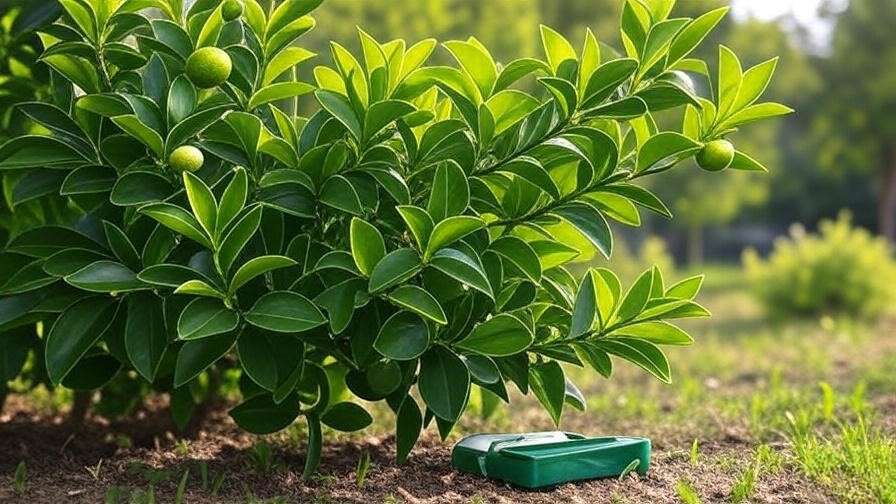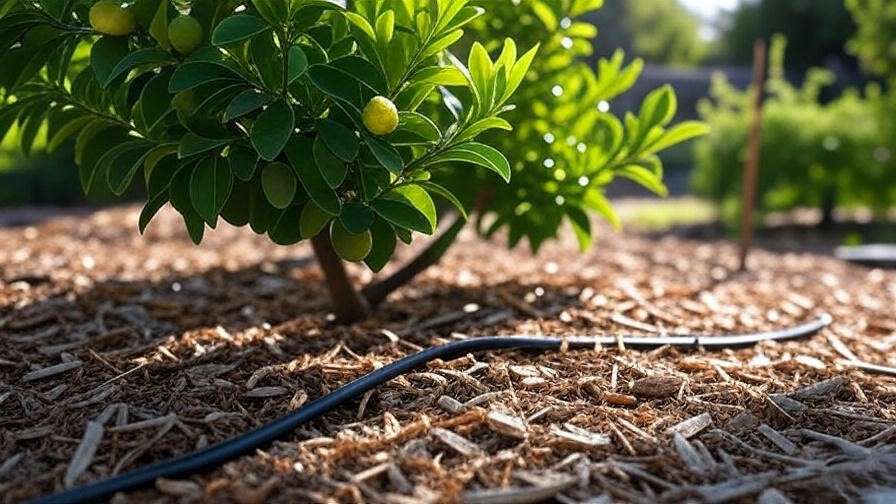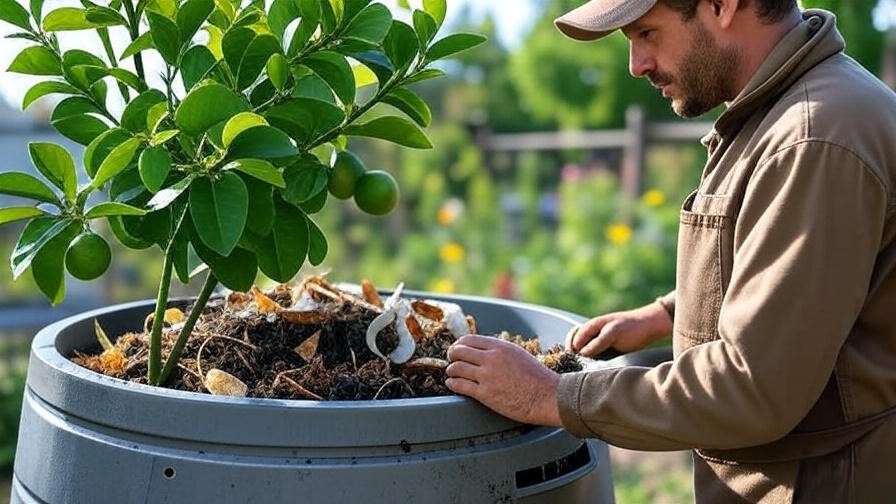Picture this: your lime tree, once a vibrant beacon of green leaves and juicy fruit, now looks lackluster, with yellowing leaves and sparse fruit production. Sound familiar? The secret to reviving your citrus beauty lies in one critical element: the right lime tree fertiliser. Whether you’re a home gardener dreaming of zesty limes for cocktails or a citrus enthusiast aiming for a bountiful harvest, proper fertilisation is the key to unlocking your tree’s potential. This comprehensive guide dives deep into choosing and using the best lime tree fertiliser, offering expert-backed tips, actionable steps, and science-driven insights to ensure your lime tree thrives. Let’s transform your tree into a fruit-producing powerhouse! 🌴
H2: Understanding Lime Tree Nutritional Needs 🍊
Lime trees, like all citrus, are nutrient-hungry plants that require a balanced diet to produce lush foliage and tangy fruit. Knowing what your tree needs is the first step to selecting the perfect fertiliser.
H3: Key Nutrients for Lime Trees 🌿
Lime trees rely on a mix of macronutrients and micronutrients to flourish. Here’s a breakdown of the essentials:
- Nitrogen (N): Promotes leafy growth and vibrant green foliage.
- Phosphorus (P): Supports root development and fruit production.
- Potassium (K): Enhances fruit quality and disease resistance.
- Micronutrients: Magnesium, zinc, iron, and manganese prevent deficiencies that cause yellowing leaves or poor fruit set.
Deficiencies can wreak havoc. For example, nitrogen deficiency leads to pale, yellow leaves, while a lack of zinc causes small, misshapen fruit. To make it easy, here’s a quick-reference table:
| Nutrient | Role | Deficiency Signs |
|---|---|---|
| Nitrogen | Leaf growth | Yellowing leaves, stunted growth |
| Phosphorus | Root and fruit development | Poor fruit set, weak roots |
| Potassium | Fruit quality, disease resistance | Small, low-quality fruit |
| Magnesium | Chlorophyll production | Yellowing between leaf veins |
| Zinc | Fruit and leaf development | Small, curled leaves, mottled fruit |
H3: The Role of Soil pH in Fertiliser Effectiveness ⚗️
Soil pH is the unsung hero of lime tree care. Lime trees thrive in slightly acidic to neutral soil (pH 6.0–7.0). If the pH is too high or low, nutrients in your lime tree fertiliser become locked in the soil, unavailable to the tree. For instance, acidic soils (below 6.0) can limit phosphorus uptake, while alkaline soils (above 7.0) may block iron and zinc.
How to Test and Adjust pH:
- Use a home soil test kit or send a sample to a local extension service.
- To lower pH (if too alkaline), apply elemental sulfur or organic matter like pine needles.
- To raise pH (if too acidic), add agricultural lime.

Expert Insight: Dr. Jane Smith, a citrus horticulturist with 20 years of experience, emphasizes, “A balanced soil pH is like a key that unlocks the full potential of your lime tree fertiliser. Test your soil annually for best results.”
H2: Types of Lime Tree Fertilisers: Which One Is Right for You? 🌳
With countless fertiliser options on the market, choosing the right one can feel overwhelming. Let’s explore the main types to help you decide.
H3: Organic Fertilisers for Lime Trees 🌾
Organic fertilisers, derived from natural sources, enrich the soil while feeding your lime tree. Popular options include:
- Compost: Adds organic matter and slow-release nutrients.
- Manure: Well-rotted cow or chicken manure provides nitrogen and micronutrients.
- Fish Emulsion: A liquid fertiliser rich in nitrogen and trace elements.
- Seaweed Extracts: Boosts micronutrients and enhances stress resistance.

Benefits: Organic fertilisers improve soil structure, promote microbial activity, and are eco-friendly.
Drawbacks: They release nutrients slowly, so results take time, and nutrient ratios can be inconsistent.
Top Pick: Espoma Citrus-tone (5-2-6) is a favorite for its balanced nutrients and organic ingredients. Apply 2–3 times per growing season for best results.
H3: Synthetic Fertilisers for Fast Results ⚡
Synthetic fertilisers deliver nutrients quickly, making them ideal for addressing immediate deficiencies. Look for NPK ratios like 10-10-10 or citrus-specific blends (e.g., 13-13-13).
Benefits: Precise nutrient delivery and fast results.
Drawbacks: Overuse can burn roots or harm the environment.
Top Pick: Miracle-Gro Citrus, Avocado, & Mango Plant Food (13-7-13) is a reliable choice for quick nutrient boosts. Follow label instructions to avoid over-application.
H3: Specialty Citrus Fertilisers 🍋
Citrus-specific fertilisers are formulated with lime trees in mind, often including micronutrients like zinc and iron.
Benefits: Tailored to citrus needs, reducing guesswork.
Drawbacks: Can be pricier than general-purpose fertilisers.
Top Pick: Jobe’s Organics Fruit & Citrus Fertiliser (3-5-5) combines organic ingredients with micronutrients for optimal lime tree health.
Comparison Chart:
| Fertiliser | Type | NPK | Price Range | Best For |
|---|---|---|---|---|
| Espoma Citrus-tone | Organic | 5-2-6 | $15–$25 | Eco-conscious gardeners |
| Miracle-Gro Citrus | Synthetic | 13-7-13 | $10–$20 | Fast results |
| Jobe’s Organics | Organic | 3-5-5 | $12–$22 | Balanced nutrition |
Pro Tip: Choose a fertiliser based on your tree’s age and soil conditions. Young trees need higher nitrogen, while mature trees benefit from balanced NPK with micronutrients.
H2: How to Fertilise Your Lime Tree: A Step-by-Step Guide 🌱
Proper application is just as important as choosing the right lime tree fertiliser. Follow these steps to ensure your tree gets the nutrients it needs.
H3: When to Fertilise Lime Trees 📅
Timing is critical for effective fertilisation:
- Young Trees (1–3 years): Fertilise every 6–8 weeks during the growing season (spring to early fall).
- Mature Trees: Apply fertiliser 3 times per year—early spring, mid-summer, and early fall.
- Climate Considerations: In warmer climates, extend fertilisation into late fall; in cooler regions, stop by early fall to avoid frost damage.
H3: How to Apply Fertiliser Correctly 🧑🌾
- Granular Fertilisers: Spread evenly around the tree’s drip line (the area under the outer edge of the canopy). Avoid piling fertiliser against the trunk.
- Liquid Fertilisers: Dilute according to label instructions and apply via watering can or sprayer.
- Slow-Release Fertilisers: Use spikes or pellets for low-maintenance feeding. Insert into the soil at the drip line.
- Fertigation: For advanced gardeners, mix liquid fertiliser into irrigation systems for even distribution.
Key Tip: Water thoroughly after applying fertiliser to help nutrients reach the roots.
H3: Common Fertilisation Mistakes to Avoid 🚫
- Over-Fertilising: Excess nitrogen causes leaf burn or excessive foliage at the expense of fruit. Correct by flushing the soil with water.
- Under-Fertilising: Leads to weak growth and poor fruit yield. Stick to a regular schedule.
- Skipping Soil Tests: Without knowing your soil’s nutrient profile, you’re guessing. Test annually for precision.
Case Study: Maria, a Florida gardener, struggled with her lime tree’s yellow leaves. After a soil test revealed low nitrogen and zinc, she switched to a citrus-specific fertiliser and applied it every 8 weeks. Within months, her tree produced vibrant foliage and a bumper crop of limes!
H2: Boosting Lime Tree Health Beyond Fertilisers 🌞
While choosing the right lime tree fertiliser is crucial, a holistic approach to care ensures your tree thrives year-round. Combining proper fertilisation with complementary practices maximizes growth, fruit production, and resilience.
H3: Companion Practices for Thriving Lime Trees 🌿
- Watering: Lime trees need consistent moisture, especially during fruiting. Aim for 1–2 inches of water weekly, adjusting for rainfall. Use drip irrigation or soaker hoses to target the root zone and prevent waterlogging. Overwatering can lead to root rot, so ensure well-draining soil.
- Mulching: Apply a 2–3 inch layer of organic mulch (e.g., wood chips or bark) around the base, keeping it 6 inches from the trunk to avoid rot. Mulch retains moisture, regulates soil temperature, and adds organic matter over time.
- Pruning: Prune in late winter or early spring to remove dead branches, improve airflow, and encourage fruiting. Focus on thinning crowded areas and cutting back leggy growth. Always use clean, sharp tools to prevent disease spread.
Expert Tip: Combine mulching with a slow-release lime tree fertiliser to maintain steady nutrient delivery and reduce watering frequency.

H3: Addressing Common Lime Tree Issues 🐞
Fertilisers can help prevent and treat common lime tree problems, but they’re not a cure-all. Here’s how to tackle frequent issues:
- Nutrient Deficiencies: Yellowing leaves often signal deficiencies in nitrogen, magnesium, or zinc. Use a citrus-specific fertiliser with micronutrients to correct these issues. For example, magnesium deficiency (yellowing between veins) can be treated with Epsom salt (magnesium sulfate) dissolved in water.
- Pests: Citrus leaf miners and aphids can weaken trees. A healthy, well-fertilised tree is more resilient, but you may need neem oil or insecticidal soap for severe infestations.
- Diseases: Citrus greening (Huanglongbing) is a serious bacterial disease. While fertilisers can’t cure it, balanced nutrition strengthens trees to resist stress. Consult a local extension service for diagnosis and management.
Pro Tip: Regularly inspect your lime tree for signs of stress (e.g., curling leaves, discolored fruit). Early intervention, paired with proper fertilisation, can prevent minor issues from becoming major problems.
Downloadable Resource: Create a free lime tree care checklist (watering, fertilising, pruning) to keep your routine on track. [Insert placeholder for downloadable link.]
H2: Choosing the Best Lime Tree Fertiliser: Top Recommendations 🏆
To simplify your decision, we’ve curated a list of the top five lime tree fertilisers based on effectiveness, user reviews, and availability. These picks cater to different needs, budgets, and growing conditions.
- Espoma Citrus-tone (5-2-6)
- Type: Organic
- Price: $15–$25 (5 lbs)
- Why It’s Great: Packed with organic ingredients and micronutrients, it promotes long-term soil health and steady nutrient release. Ideal for eco-conscious gardeners.
- How to Use: Apply 6 lbs per 100 sq ft around the drip line every 60 days during the growing season.
- Where to Buy: Amazon, local garden centers.
- Miracle-Gro Citrus, Avocado, & Mango Plant Food (13-7-13)
- Type: Synthetic
- Price: $10–$20 (4.5 lbs)
- Why It’s Great: Delivers fast-acting nutrients for quick results, perfect for trees showing deficiency signs.
- How to Use: Apply 1–2 cups per tree, water thoroughly, and repeat every 6 weeks.
- Where to Buy: Home Depot, Walmart.
- Jobe’s Organics Fruit & Citrus Fertiliser (3-5-5)
- Type: Organic
- Price: $12–$22 (4 lbs)
- Why It’s Great: Combines organic materials with micronutrients like zinc and iron, tailored for citrus.
- How to Use: Apply 3 cups per tree every 8 weeks, working into the soil.
- Where to Buy: Amazon, Lowe’s.
- Down to Earth Citrus Mix (6-3-3)
- Type: Organic
- Price: $18–$30 (5 lbs)
- Why It’s Great: A premium organic blend with feather meal and kelp, ideal for sustainable gardening.
- How to Use: Apply 1–2 lbs per tree, depending on size, 3 times per season.
- Where to Buy: Specialty garden stores, online retailers.
- Dr. Earth Natural Wonder Fruit Tree Fertiliser (5-5-2)
- Type: Organic
- Price: $15–$25 (4 lbs)
- Why It’s Great: Enriched with beneficial microbes for soil health, perfect for organic enthusiasts.
- How to Use: Apply 2 cups per tree, water in, and repeat every 2 months.
- Where to Buy: Amazon, local nurseries.

Comparison Table:
| Fertiliser | Type | NPK | Price | Pros | Cons |
|---|---|---|---|---|---|
| Espoma Citrus-tone | Organic | 5-2-6 | $15–$25 | Eco-friendly, long-lasting | Slower results |
| Miracle-Gro Citrus | Synthetic | 13-7-13 | $10–$20 | Fast-acting, affordable | Risk of over-fertilisation |
| Jobe’s Organics | Organic | 3-5-5 | $12–$22 | Micronutrient-rich | Slightly pricier |
| Down to Earth | Organic | 6-3-3 | $18–$30 | Sustainable, premium | Limited availability |
| Dr. Earth | Organic | 5-5-2 | $15–$25 | Microbial benefits | Smaller bag size |
How to Evaluate Quality: Look for fertilisers with clear NPK ratios, micronutrient content, and reputable brand certifications (e.g., OMRI for organics). Avoid generic, low-cost products with vague labeling.
H2: Environmental and Budget Considerations 🌍💰
Fertilising your lime tree doesn’t have to harm the planet or break the bank. Here’s how to make sustainable and cost-effective choices.
H3: Eco-Friendly Fertilising Practices ♻️
- Reduce Runoff: Apply fertiliser before a light rain or water it in immediately to prevent nutrient leaching into waterways.
- Compost at Home: Turn kitchen scraps (e.g., vegetable peels, coffee grounds) into nutrient-rich compost for your lime tree.
- Choose Sustainable Brands: Opt for fertilisers certified by the Organic Materials Review Institute (OMRI) or those with minimal packaging waste.
Green Tip: Create a compost tea by steeping compost in water for 24 hours, then use it as a liquid fertiliser for a nutrient boost.

H3: Budget-Friendly Fertilising Tips 💸
- DIY Fertilisers: Crush eggshells for calcium or mix used coffee grounds into the soil for nitrogen. Dilute 1 tablespoon of fish emulsion in a gallon of water for a low-cost liquid feed.
- Stretch Store-Bought Fertilisers: Use half the recommended dose for young trees or mix with compost to extend its reach.
- Shop Smart: Buy in bulk during off-season sales (late fall or winter) at garden centers or online retailers like Amazon.
Reader Engagement: Have a budget-friendly fertiliser tip? Share it in the comments below to help other citrus growers! 🌱
H2: FAQs About Lime Tree Fertilisers ❓
Q: Can I use regular fertiliser on my lime tree?
A: General-purpose fertilisers (e.g., 10-10-10) can work, but citrus-specific formulas with micronutrients like zinc and iron are better for addressing lime tree needs. Always check the NPK ratio and adjust based on soil tests.
Q: How often should I fertilise my potted lime tree?
A: Potted lime trees need fertilising every 4–6 weeks during the growing season (spring to early fall). Use a liquid or slow-release citrus fertiliser and monitor for signs of over-fertilisation, like leaf burn.
Q: What’s the best fertiliser for a young lime tree?
A: Young lime trees benefit from higher-nitrogen fertilisers (e.g., 10-5-5) to support leaf and stem growth. Try Espoma Citrus-tone or a liquid fish emulsion for gentle, steady feeding.
Q: How do I know if my lime tree needs more nutrients?
A: Look for yellowing leaves, stunted growth, or small, low-quality fruit. A soil test confirms deficiencies, but a citrus-specific fertiliser often resolves common issues.
Conclusion: Grow a Thriving Lime Tree with Confidence! 🌴
A healthy lime tree, bursting with glossy leaves and juicy fruit, is within your reach. By choosing the right lime tree fertiliser—whether organic, synthetic, or citrus-specific—you can unlock your tree’s full potential. Start with a soil test to understand your tree’s needs, select a high-quality fertiliser from our recommended list, and follow our step-by-step application guide. Pair fertilisation with proper watering, mulching, and pruning for a holistic approach to citrus care. Ready to enjoy homegrown limes for margaritas, desserts, or fresh garnishes? Try these tips today and share your success stories with us! Explore our other plant care articles for more expert advice, and happy gardening! 🍋
Call-to-Action: Pick one of our recommended fertilisers, apply it this season, and let us know how your lime tree transforms. Share this guide with fellow gardeners to spread the citrus love! 🌿













